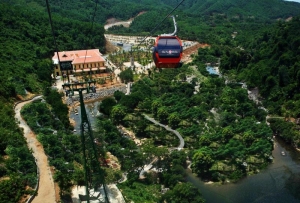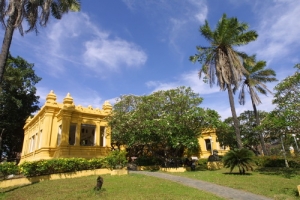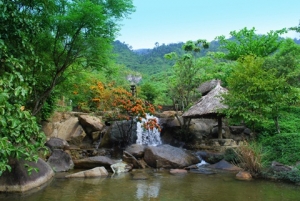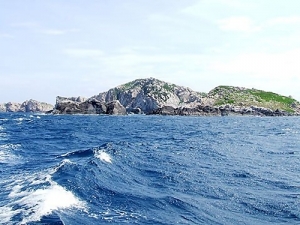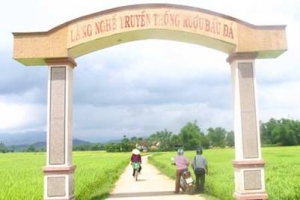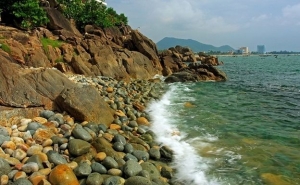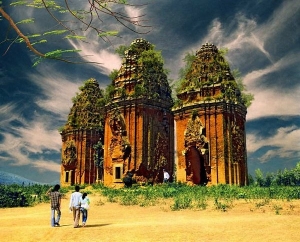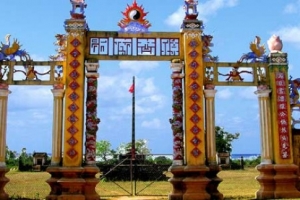
Asia Pacific Travel Team
Ba Na Mountain Resort- An ideal destination on Central Vietnam
As not far from Danang city, only about 50km to the west, tourists in Vietnam travel can finally reach one of the most spectacular sights you would have ever visited. With a height of 1,487 meters above the sea lever and a temperate climate, Ba Na Mountain is a real treasure of the country.
For many reasons, travelers joining tours in Vietnam come to Ba Na, but no one can deny that the rejuvenating atmosphere and the wonderful scenery of Ba Na influence them the most when deciding to come to this unique land. To get to the top of Ba Na Mountain, tourists would have to conquer a 15-kilometer zigzag road if they visited some years ago (the topography there is pretty flat like a mini highland, luckily!). Nowadays, as the longest cable car system in the world has been constructed there, no one have to bear the long and taunting 15-kilometer trip anymore. You can still do if you happen to be an adventurer, but it is highly recommended that you take the cable car. The reason is not for safety, of course but you will gain the rewarding experience of looking over a huge scenery of Danang City, VungThung bay, Hai Van Pass, Son Tra Peninsula, My Khe Beach, Marble Mountain and Thu Bon River, Cu Lao Cham Island. In only a ride, you will witness a like-no-other Fengshui picture.
Each of the four seasons appears within a single day in Ba Na: spring in the morning, summer at noon, autumn in the afternoon and winter at night. One particular characteristic is that the clouds are at the mid-height of the mountain, so the peaks are always clear. Ba Na also possesses very beautiful forests with green pine hills.
Moreover, Ba Na has a diverse ecosystem, including primitive jungles which are home to 256 animal species and 543 plants species, eco-tourism has developed there for a long time. Particularly, many villages, resorts and hotels have been built on the slopes of Ba Na Mountain and King Mountain since the beginning of the 20th century. Even though the wars have destroyed a great part of these constructions, they have been restored recently to their former glories.
With its wild beauty endowed by the Nature, Ba Na Mountain welcomes thousands of visitors from everywhere in the world annually. It promises to attract more tourists in Vietnam, contributing to the tourism development of Danang city next time.
Champa Sculpture Art Museum in Danang, the heart of ancient Champa Kingdom
Coming to visit the Museum of Cham Sculpture in Danang city, whether in the morning or in the afternoon, on rainy or sunny days, visitors in Vietnam travel still perceive an individual atmosphere particular to this place, the reverie of reminiscences.
With the support of the Far-East Archaeological Research Institute in Hanoi, the Museum of Cham Sculpture was built in 1915 and now it has nearly 2000 large and small sculptures, of which 288 are on display inside the museum, 187 objects in the garden and more than 1.200 objects are reserved in the storehouse. Most of the sculptures in the museum are original and mainly of three kinds of materials, including sandstone, terracotta and bronze. The majority of these sculptures from the 12th to the 15th century are made of sandstone with different art styles.
The sculptures displayed here almost have the same drifting life as the very destiny of the once-glorious culture that generated them. Through the ruins of time, war and even the oblivion, such original Champa sculptures were hardly collected and brought here by many human generations. And in this systematic collection, these works of the ancient Champa artists again have a new life.
Visiting the museum, it seems that we see again the glorious time of the past of a nation for whom both the passion for art and the creative talent were already at a very high level. The mysterious world of deities, the pictorial legends, the religious symbols, the curving lines of the bodies of dancing girls, the features of full swelling breasts, the smiles of a vague time, etc, all of these are shown very lively and in much in details.
Despite profoundly influenced by the architecture and sculpture of the Indian civilization, the ancient Champa, nevertheless, has a vision of life and religion according to their own feeling. Such refraction brought to their world of art a really distinct beauty. It is spiritual though it is very close; it has unique though it is familiar. It is a subtle and distinctive beauty. Visitors in Vietnam tourism will have a chance to relax and feel themselves immersed in the golden past of Cham civilization.
Ngu Hanh Son or the Landscape of Southern Sky, Danang Marble Mountains
A 9 km drive from the south of Danang city center on the famous beachfront boulevard Truong Sa, tourists in Vietnam travel can find one of the most popular attractions of the region, the Marble mountains. It is a cluster of five marble and limestone mountains, named after the five elements of the ancient oriental philosophy: metal, wood, water, fire and earth.
In the early 19th century, King Gia Long, the founder of the Nguyen Dynasty, passed by and named the five mountains as Ngu Hanh Son. He also named each of them according to one of the five elements of the universe: Kim Son (metal of gold), Moc Son (wood), Thuy Son (water), Hoa Son (fire), and Tho Son (earth). According to Oriental philosophy, metal, wood, water, fire and earth are five elements that create the universe. Five is a very important number in oriental mentality and life. And so, the five mountains that compose Marble Mountain are filled with mysterious.
Thuy Son is both the highest and the most beautiful. Marble mountains are associated with different legends. Thuy Son, covering an area of 15ha, has three peaks namely Thuong Thai, Trung Thai and Ha Thai. As a result, the pagoda built on the mountain was named Tam Thai. Thuy Son has been exploited as a popular tourist resort because of its alluring beauty. Stone steps carved into the mountain lead to Tam Thai Pagoda where Phat Di Lac is worshipped. In the past, the pagoda paid tribute to Hindu and Buddhist gods and is now dedicated to Cham deities. Also on the cliff of the mountain are such beautiful grottoes as Linh Nham Grotto, Van Thong Grotto, Tang Chon Grotto and Huyen Khong Grotto. Huyen Khong Cave was the base for Vietnamese revolutionaries during wartime.
The Marble Mountains are famous for their traditional stone engraving activities. In Dong Hai village close to Thuy Son, 600 families chisel stone producing statues, jewelry, and art work. Stone from the Marble Mountains has been exported to many countries.
Cultural and historical vestiges are still on every pagoda and tower of the early 19th century and on Champa sculptures of the 14th and 15th century. There are poets of the Le and Tran dynasty engraved on stones. All monuments such as the grave of Capital Tran Quang Khai’s mother, a temple for worshiping Ngoc Lan princess (Minh Mang King’s younger sister), autograph of conferring Tam Thai pagoda to be the national one, Da Chong tunnel, Ba Tho cave, Kim Son mountain, Am Phu cave, etc. are forceful evidences to the legendary Marble Mountains.
The stone carving village stretching along the road leading to the Ngu Hanh Son entrance is also a very attractive sight for visitors in Vietnam tourism. At this village, you can admire all those wonderful works created by patient craftsmen right in front of you. All the stones for the works are taken and transferred from the Marble Mountains.
The Marble Mountains are situated between Da Nang City and Hoi an ancient town and very close to Non Nuoc Beach, which stretches for kilometers with clean and white sand and is one of the nicest beaches in Vietnam, which is very convenient for visitors who want to go climbing and bathing. Ngu Hanh Son is familiar to almost everyone who has been to Da Nang. It is so well known that many people consider it as the symbol of the era.
Flower Spring (Suoi Hoa) - an attractive ecotourism site in Vietnam travel
Flower Spring, the name associated with the majestic Truong Son Dong moutain.This is one of the attractive destinations in Vietnam that nature endowed with adequate human elements to create eco-tourism such as rivers, streams, mountains, forests, waterfalls, lakes, … with the animal population is very diverse and rich.
Highlights of Flower Spring is the flower forest covered a large area and form a very comfortable feeling for guests. Flower Spring of forest sites along a spring bloom red brick pride and honor in the land of sky blue. At the place, the stream confluence with the East River after crossing the waterfall from a height of several hundred meters retain the purity of water and carry the headwater of the great cool thousand primary Ba Na – Mountain of God. Indeed, Flower Spring has never been dry, even on the most severe droughts in the Central Region.
Flower Spring is located in Hoa Phu Commune, Hoa Vang district, Da Nang with the people of Co Tu ethnic gentle, patriotic tradition and hospitality, always maintaining a sense of majestic mountains. Flower Spring has a cool climate all year round, ideal for the reunion fun, rest and recuperate. Located about 35 kms from Da Nang, Flower Spring is a good location for outdoor activities and family nature of collective manner through the night or go on the day.
Early in 1992 after the Danang People’s Committee approved Flower Spring Resorts project, Phuoc Hung Company started work on clearing the jungle area of original forest on 40 hectares of hilly land. Clearing medium build, medium maintained by a Flower Spring system is pristine waterfall, nature, a majestic natural beauty. Tourism zone gradually formed. The surrounding mountains seem to became more imposing, more luxurious vegetation with the services arranged skillfully. All make a wonderful harmony between nature and man.
After five years of development effort, on 29/03/1997, Flower Spring Ecological Resort operated officially. Since then, Flower Spring Ecological Resort have been recepted tens of thousands of foreign and domestic visitors. During the operation, Flower Spring Ecological Resort gradually improves the service type matches the green space, clean, bold and modern ecological, improves in service quality to meet the increasing demand of travelers in Vietnam travel.
In the near future, Flower Spring Ecological Resort is going to continue to invest in further development and construction projects more than entertainment, resorts, villas, expand and enhance the quality of service to reply emotion, attention and trust of partners and the tourists in Vietnam tourism.
Swallow Island in Binh Dinh
In the rainy reason, the rivers, streams in the southern valley of Tam Dao mountains and also Vuc Tuyen River, Ton river, Ba Ha River, Dong Cau River, Dong Chao River…all push the water into Dai Lai Lake. This makes the water level able to increase to 21 meters. Despite of being large, the lake surface doesn’t make the visitors feel spacious, they can discover many interesting scenery when boating across defiles which are still strangely wild.
In the north of Dai Lai Lake, visitors can see Tam Dao Mountains which are very high and further green vast forests. In three sides of the lake surface, after the continuous upturned-bowl hills, there is Than Lan Mountain which is followed next by stable dams forming the wall keeping water. About 9,000 hectares of protective forests are planted around the lake. From the swimming area in the lake, the visitors can go straight to the top of Than Lan Mountain in the south to keep their sight away toward Hanoi capital which is sparkling under the afternoon sunshine.

People being interested in climbing can make a travel to the North, pass the forests and Nhe Mountain Pass to enter Thai Nguyen area or turn to Mo Qua Mountain to try climbing on the cliffs which are high until sky. From the height, people can blearily see Xa Huong Lake, Lang Ham Lake, Gia Khau Lake… in the forest, behind the sign of ancient kingdom of General Nguyen Danh Phuong who had built his own separate country and fought against the empire of King Le – Emperor Trinh for ten years.

Mo Qua Mountain in the north of Dai Lai
The blue color of the deep lake rounded by green of the forests and high mountains as well as cool winds blowing from three sides of the lake surface bring to visitors the peaceful, pleasant feelings which are rarely found.

Green pine forest in Dai Lai
Especially since early years, many flocks of mysterious birds have flied to and gathered many and many in the islands among the lake, this is a strong proof of the pure air in natural environment here. Every afternoon, the white storks blearily fly shading on the lake surface, the birds sing beautifully and the pine forests whizz, that natural show will be very attractive call for the guests to come here.
Eo Gio captures beauty of Quy Nhon
Coming to Quy Nhon, visiting Eo Gio to hear the wind whispering through mountain walls, caves and then harmonize with waves crashing onto the shore is a must.
You can also admire rock cliffs shaped like they are trying to hold the ocean and to view a rookery of albatrosses hovering in the sky.
Eo Gio is an arc-shaped strait in Hung Luong Hamlet, Nhon Ly peninsula commune, Quy Nhon City, Binh Dinh Province. People call it Eo Gio (Wind’s waist) as seen from above, Eo Gio looks like a funnel with two rock ranges holding a sea corner.
In the past, it wasn’t easy for visitors coming to Eo Gio as they needed to take a motorbike to Ham Tu Wharf then cross over to Thi Nai Lagoon for the numerous deserted sand dunes. However, now tourists just make a 20-kilometer motorbike trip over Thi Nai Bridge to Nhon Ly Commune.
The route to Eo Gio is also stunning and primitive. On the bridge, tourists can take a panoramic view of Thi Nai Lagoon and the peaceful Quy Nhon City. Along the street are deserted white sand dunes which are littered with polar tree lines.
Eo Gio is beautiful in its own way with its rock cliffs in varied shapes running to the sea. The mountain holds the sea, the sea plays around the mountain, waves crash onto the shore with the sound of love songs, in the distance studded with boats and birds twittering on the sky. Seen from above, Eo Gio looks very attractive, wild and primitive.
The splendid landscapes will release all your tiredness after a long trip. As one of the most famous destinations in Quy Nhon, Eo Gio still keeps its untouched beauty.
Trekking over the peak of rock cliffs, tourists will be served a natural music show by winds through stone slits in harmony with the sounds of waves and twittering of birds.
Then walking along the rock beach, you will discover many small caves and stalactites. Amidst the rock is a stream like a silk strip falling over the rock.
Bau Da wine - a famous specialty of Binh Dinh province
Bau Da wine is a famous specialty of Bau Da village in the central province of Binh Dinh.
The name of Bau Da originated from Cu Lam village’s Bau Da in An Nhon district’s Nhon Loc commune, 22km from Quy Nhon city.
This wine is entirely made by hand.
It is said that Bau Da wine makes drinkers have sensations of fire and ice. As a matter of fact, get a drop of wine on your skin, and you will get a chilly feeling.
 Pour this wine from a height to hear the marvelous sound of wine splashing. Then let the glass of wine spread it fragrance through the atmosphere for a moment before sipping it and feeling it foam around mouth.
Pour this wine from a height to hear the marvelous sound of wine splashing. Then let the glass of wine spread it fragrance through the atmosphere for a moment before sipping it and feeling it foam around mouth.
Locals say that northern and southern tourists treated to Bau Da wine have said it is better than Johnny Walker brandy.
It is made of newly-harvested rice grains and special water, which make it transparent, and then distilled with straw and husk-fired heat.
However, the most attractive aspect of Bau Da wine is that intimate friends prefer to sit cross-legged on the floor on a moonlit night to both enjoy wine and recitals.
If tourists in Vietnam Travel have chance to visit Binh Dinh province, you should try Bau Da wine on a moonlit night. it is very interested!
Discovering the natural and Champa culture beauty of Binh Dinh Province
The central province of Binh Dinh entices nature lovers with its diversity of coastline, mountains, rivers, swamps, lakes, islands, fields, countryside villages and traditional festivals. The province is nationally known for producing talented martial artists and as the birthplace of national hero Quang Trung Nguyen Hue.
 "Egg Stone" in Ghenh Rang Beach
"Egg Stone" in Ghenh Rang Beach
Thi Nai Lagoon is the largest lagoon in Binh Dinh at more than10 kilometers long and 4 kilometers wide and is a source of delicious seafood. On a small island in the lagoon is a small temple which was built by the villagers to worship the Water God. East of the lagoon, Phuong Mai Peninsula guards Quy Nhon city. North of the peninsula are beautiful beaches reaching to Phu Cat district.
Ham Ho Tourist Area is a 3-kilometer stretch of river that winds through the forest and is especially popular with fish who love to gather here during flood season.
Thanh Mountain stands like a moss covered city wall. Hoi Van Hot Spring in Cat Trinh, Phu Cat district is a traditional healing institute. It is said that water from this source saved the life of a Cham princess, so it is also called Fairy Spring.
One-Mountain Lake in Nhon Tan commune has a surface area of over 1,200 hectares. Around the lake are springs, waterfalls, caves and primary forest and its sheet glass surface begs for skiers. Near the lake, residents of Bana village usually invite tourists to party with them.
 Banh It Tower
Banh It Tower
The Banh It Tower complex in Tuy Phuoc district’s Phuoc Hiep commune consists of four towers dating back to the 11th century. Each tower has its own specific architecture and on the top of each is a stone statute of the God Shiva.
 Duong Long Tower
Duong Long Tower
Duong Long Tower in Tay Son district’s Binh Hoa commune is a group of three Cham Towers that were built at the end of the 12th century, the most prosperous stage of the development of Cham art. The middle tower is 24 meters high and the two towers that flank it are 22 meters high. Sculptures here are glamorous yet delicate and the lively animal motifs are mysterious. Duong Long is considered one of the most beautiful towers in Vietnam.
 Canh Tien Tower
Canh Tien Tower
Canh Tien Tower one of the towers of typical Binh Dinh architectural style (dating back to the 12th century). Its structure is composed of the front hall and shrine (now, the front hall has collapsed). The outer walls are decorated with pilasters and vertical, protruding frames. Different from other Cham Towers, the pilasters and edges of the roofs of Canh Tien Tower are built of sandstone. At the four corners of each tower’s storey are stone motifs of phoenix tail. In the distance, Canh Tien Tower looks like a great, flashing fire.
 Doi Tower
Doi Tower
Doi Tower site was built in the late 12th century and early 13th. Here, there are 2 towers of 18m and 20m in height respectively. Both of them have got a special structure different from traditional, multi-storey towers. They are composed of two main parts: the square-shaped body and the similarly curved roof. Besides the aforesaid towers, in Binh Dinh Province there are also Phu Loc Tower located at Nhon Thanh Commune, An Nhon District (35 km northwest of Qui Nhon City), Thu Thien Tower in Binh Nghi Commune, Tay Son (35 km from Qui Nhon City), and Binh Lam Tower in Phuoc Hoa Commune, Tuy Phuoc District (22 km from Qui Nhon City) which was built between 11th and 15th century in the time of the Champa Kingdom.
Duong Long Cham Tower - the most beautiful and unique Cham Tower
Location: Duong Long Cham Tower is located at Go Dang, Binh Hoa Commune, Tay Son District, Binh Dinh Province.
Characteristics: This towner is a group of 3 biggest towers. It was built in the 12th century with very beautiful architecture.
Duong Long Cham Tower, also called Thap Nga meaning "ivory tower," is located 40km from Quy Nhon and 270km from Da Nang City. It is a group of 3 towers; the highest tower, 35m high, is in the middle, and the two others are 22m.

motifs with stone carvings of sacred animals
The tower’s body is built of bricks. The corners have got motifs with stone carvings of sacred animals such as Garuda birds, elephants, and eagles. Its gate faces the east and is rather high (about 1.5m) and the gate’s frame is made of big stones. Its upper part is built of big stones, which are skillfully superimposed on each other. Many big, body leaf-shaped bas embossments describing monks, dancers and singers are found on the walls. These figures with rather big heads wear corner hats. Especially, the top of the tower looks like a great lotus with its rising petals.
All the decorative motifs of the tower are very big and carved on sandstone. They are well-preserved. This tower complex is one of the most beautiful in Central Vietnam.
If tourists in Vietnam Travel have chance to visit Binh Dinh province, Duong Long Cham Tower is a must-see place that should not be missed!
Hoang De Citadel - the last capital of the Champa Kingdom
Location Located at 27km north-west of Qui Nhon City in Nhon Hau Commune, An Nhon District, Binh Dinh Province.
Characteristics: The citadel was built at the end of the 10th century, during the reign of Emperor Yangpuku Vijaaya.
This was the last capital of the Champa Kingdom where the Cham Kings lived between the 11th and the 15th centuries. Several pieces of stone walls, moats, and granite-tiled roads remain from the Citadel.

statues of small lions
Inside the Citadel, there are ancient Cham remains, such as square wells and statues of small lions and elephants. Next to the back door is Thap Thap Hill (Ten Tower Hill), on which there are ten Cham Towers. Of note is the 20m-high Canh Tien Tower with white-stone statues of a snake, two elephants, and monsters on the corners. There are many remains and objects related to Cham culture and the Tay Son movement in Thap Thap Di Da Pagoda and Nhan Thap Pagoda, two ancient pagodas situated to the north and south of the citadel.
In 1778, Nguyen Nhac proclaimed himself the Central Emperor. He established the capital, which he named Hoang De Citadel, expanded the citadel to the east, and built many grand monuments. In 1799, the citadel was occupied by the Nguyen Dynasty, and rebaptized Binh Dinh Citadel. In 1814, the Nguyen Dynasty destroyed the old citadel and built a new one about 5km south of the old citadel.


